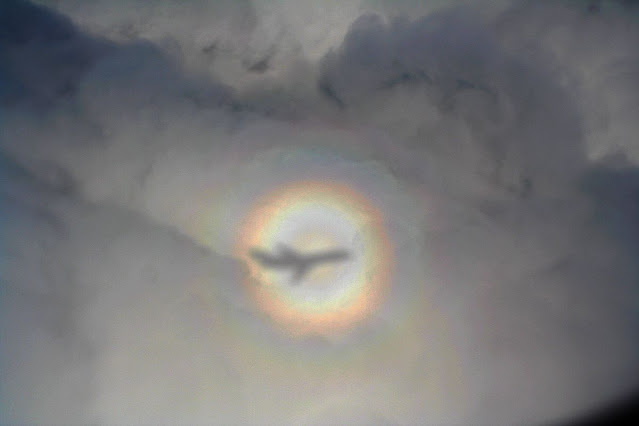When Taking Photos in Bright Sun Avoid the Sun's "Aura"
What's the sun's glory or aura and why avoid shooting into it when taking photos of people on a sunny day?
If you've ever flown in an airplane and looked down at the plane's shadow on a layer of clouds you've probably seen the bright circular halo reflection the sun makes when it's high overhead. It is sometimes called a "glory" because it looks like a halo.
The Hot Zone. That "glory" or rainbow like aura is always present even on the ground when you are taking photos on a sunny day and it can ruin your shots. Let's call it the Hot Zone. When your subject is in the Hot Zone it can make your subject look as if you used an onboard flash, or washing out the contrast and the colors.
Here's an example. The runner looks as if I used a flash. But this is the untouched RAW file shot with the early morning sun around 8:30am directly behind me. It was shot on a Nikon D850 with natural light.
Notice how dark the background is because the subject is so much brighter due to Hot Zone glare. And notice that his shadow is directly behind him. That means I'm perfectly lined up with the sun relative to him. That's usually bad. That's the Hot Zone. And no amount to Lightroom tweaking really helped this image later. It just looked "off" no matter what tricks I did.
The Hot Zone happens when you accidentally line up the angle of the sun behind you (over your shoulder as the old advice goes) with your subject and your camera. And when the sun is low it's more likely.
I should add that the Hot Zone is not just the circular halo hot spot, but there is also a line of glare extending both up and down from the halo. So even if you're not lined up top to bottom with the sun behind you, you still get a zone of strong glare if you and your subject are lined up left to right.
And using a telephoto lens or cropping in just magnifies it. You could fill your entire frame with all that harsh light and wash out the colors and contrast and at the same time look harsh and unflattering.
Notice again below how the subject of this untouched photo below, taken around 8:30am with natural light, looks almost like I used a flash. And her shadow is directly behind her. I'm perfectly lined up with the sun behind me relative to her. Despite the sun being low and warm her being in the Hot Zone makes the colors seem off, flat and harsh. It was shot in RAW with a Nikon D850 at ISO 800 at 300mm and is cropped in to the subject who was at the center of the frame.
You can see from the blown out white running card the amount of harsh "bounce" off her and back to my camera. She is in the Hot Zone. If she were maybe 5 feet left or right she'd be out of that zone.
You can see what's happening on this lens hood.
The sun's aura is basically back scatter. Underwater photographers are familiar with this. If you put your flash on your camera under water then the light bounces strongly back to you off of all the particles and plankton in the sea water. Look at this grouper photo I took years ago. It's not just back scatter, but the same Hot Zone off the fish too. Double whammy. That's why underwater rigs always have the flash off to the side.
The solution to the Hot Zone (on land) is to simply move your subject, or yourself, a bit to the left or right and get them out of the sun's Hot Zone aura.
Look at this photo, just a few feet to the right of the previous. See how nice the light is, and balanced with the background. Only my position changed and by just a few feet.
When is the Hot Zone helpful?
Believe it or not there are times it can help you. Try taking a photo of a black or dark duck on a pond where the water is also dark and the sun is somewhere behind you.
Getting that duck right in the Hot Zone can actually boost it's relative brightness to the background water by a stop or so, and bring out the details on it's feathers and eyes. Move or wait until the duck, or similar subject/background, moves into the Hot Zone and take some shots.












Comments
Post a Comment